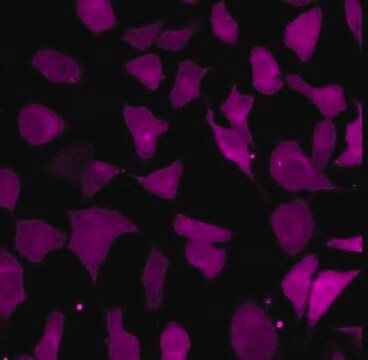SCT053
BioTracker SiRNO (Nitric Oxide)- Near Infrared Live Cell Dye
Live cell imaging dye for cellular nitric oxide (NO) localized to mitochondria and lysosome, used as an indicator of host defense, homeostasis and developmental functions.
Synonim(y):
Live cell imaging probe
Zaloguj sięWyświetlanie cen organizacyjnych i kontraktowych
About This Item
Kod UNSPSC:
12352207
NACRES:
NA.47
Polecane produkty
Próba
≥98% (H-NMR)
≥98% (HPLC)
≥98% (LC/MS)
≥98% (elemental analysis)
metody
cell based assay: suitable
metoda wykrywania
fluorometric
Opis ogólny
Nitric oxide (No) is a reactive nitrogen species which is produced by nitric oxide synthase (NOS). NO is involved in many physiological processes including regulation of blood pressure, homeostasis, activation of immune system, neural communication, contraction of both smooth muscle and vascular tissue. Therefore, detection and quantification of NO is critical to understanding health and disease.
The BioTracker<TMSYMBOL></TMSYMBOL> SiRNO-Nitric oxide dye is a live cell near-infrared fluorescent imaging probe for detecting nitric oxide (NO). The probe targets NO specifically in the mitochondria and lysosome of living cells. The probe shows no cross reactivity to a variety of biomolecules and other reactive species including: ascorbic acid (AA), dehydroascorbic acid (DHA), methylglyoxal (MGO), GSH, Cys, Hcy, H2O2, ClO−, -OH, O2−, NO2−, and ONOO−. The SiRNO dye is pH insensitive in the range of 5.5 - 8.0, showing that it is suitable for physiological pH range. The SiRNO dye has been successfully used to detect NO in live cells, animal tissue and in vivo experiments.
Spectral Properties
Absorbance: 633nm
Emission: 650-750nm
The BioTracker<TMSYMBOL></TMSYMBOL> SiRNO-Nitric oxide dye is a live cell near-infrared fluorescent imaging probe for detecting nitric oxide (NO). The probe targets NO specifically in the mitochondria and lysosome of living cells. The probe shows no cross reactivity to a variety of biomolecules and other reactive species including: ascorbic acid (AA), dehydroascorbic acid (DHA), methylglyoxal (MGO), GSH, Cys, Hcy, H2O2, ClO−, -OH, O2−, NO2−, and ONOO−. The SiRNO dye is pH insensitive in the range of 5.5 - 8.0, showing that it is suitable for physiological pH range. The SiRNO dye has been successfully used to detect NO in live cells, animal tissue and in vivo experiments.
Spectral Properties
Absorbance: 633nm
Emission: 650-750nm
Zastosowanie
Live cell fluorescent imaging
Live cell imaging dye for cellular nitric oxide (NO) localized to mitochondria and lysosome, used as an indicator of host defense, homeostasis and developmental functions.
Research Category
Cell Imaging
Cell Imaging
Research Sub Category
Live Cell Dye
Live Cell Dye
Jakość
Purity: ≥ 98% confirmed by HNMR, LC-MS and HPLC and elemental analysis
Molar Mass: 758.34 g/mol
Molar Mass: 758.34 g/mol
Postać fizyczna
Lyophilized
Przechowywanie i stabilność
Store BioTracker SiRNO-Nitric Oxide Live Cell Dye at -20°C, desiccate and protect from light
Note: Centrifuge vial briefly to collect contents at bottom of vial before opening.
Note: Centrifuge vial briefly to collect contents at bottom of vial before opening.
Oświadczenie o zrzeczeniu się odpowiedzialności
Unless otherwise stated in our catalog or other company documentation accompanying the product(s), our products are intended for research use only and are not to be used for any other purpose, which includes but is not limited to, unauthorized commercial uses, in vitro diagnostic uses, ex vivo or in vivo therapeutic uses or any type of consumption or application to humans or animals.
Ta strona może zawierać tekst przetłumaczony maszynowo.
Kod klasy składowania
11 - Combustible Solids
Klasa zagrożenia wodnego (WGK)
WGK 3
Temperatura zapłonu (°F)
Not applicable
Temperatura zapłonu (°C)
Not applicable
Certyfikaty analizy (CoA)
Poszukaj Certyfikaty analizy (CoA), wpisując numer partii/serii produktów. Numery serii i partii można znaleźć na etykiecie produktu po słowach „seria” lub „partia”.
Masz już ten produkt?
Dokumenty związane z niedawno zakupionymi produktami zostały zamieszczone w Bibliotece dokumentów.
Zhiqiang Mao et al.
Analytical chemistry, 89(18), 9620-9624 (2017-08-29)
Two-photon (TP) fluorescent probes are potential candidates for near-infrared (NIR) imaging which holds great promise in biological research. However, currently, most TP probes emit at wavelength <600 nm, which impedes their practical applications. In this work, we explored the TP
Nasz zespół naukowców ma doświadczenie we wszystkich obszarach badań, w tym w naukach przyrodniczych, materiałoznawstwie, syntezie chemicznej, chromatografii, analityce i wielu innych dziedzinach.
Skontaktuj się z zespołem ds. pomocy technicznej







